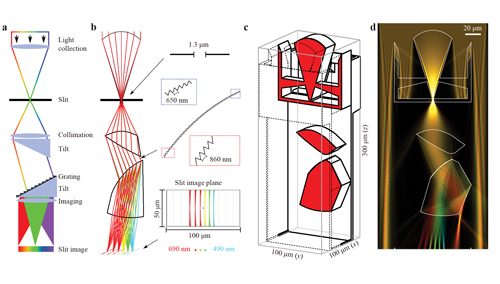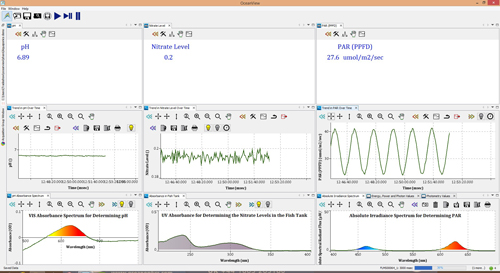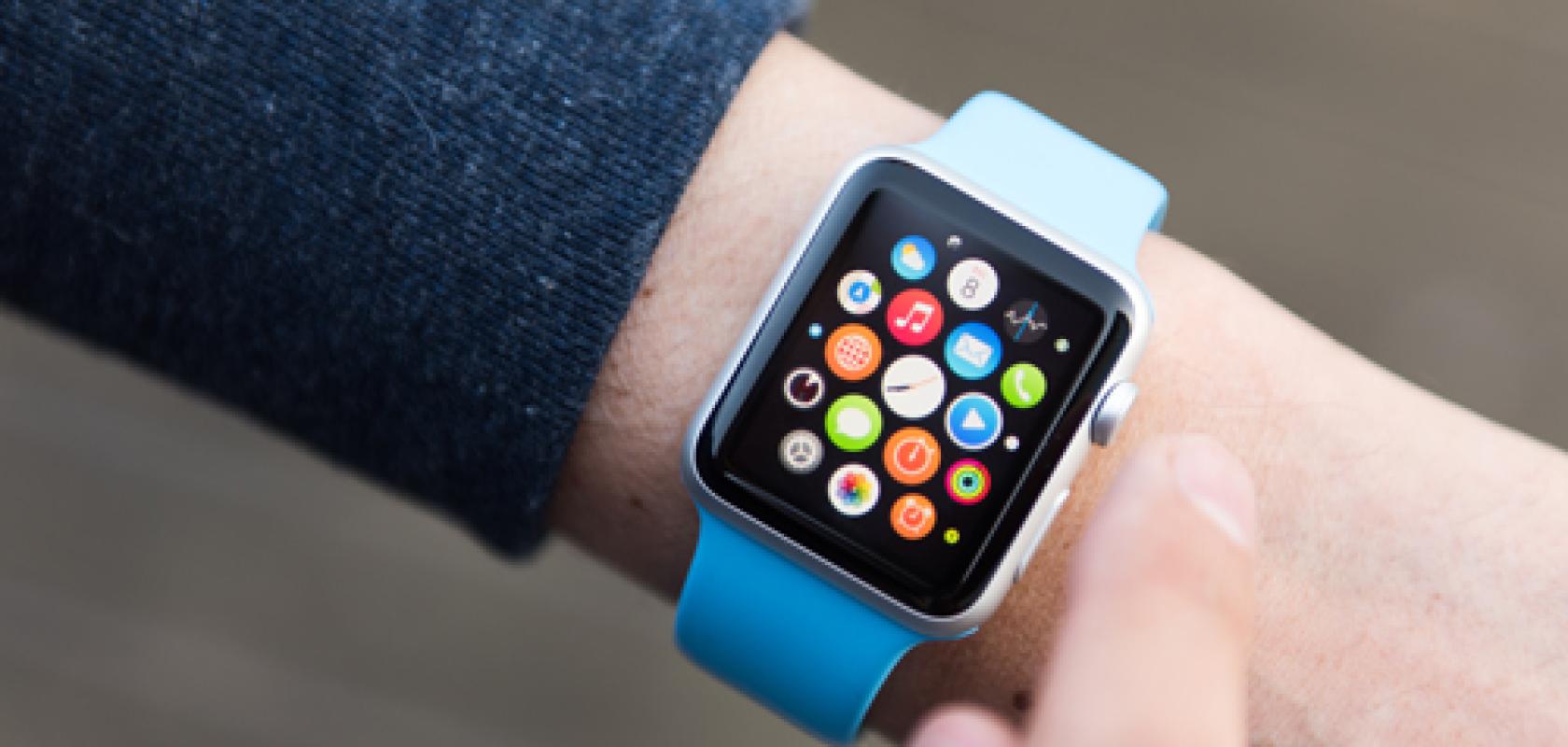Spectrometers are used in several applications for chemical and biological sensing and material analysis. As these instruments – which not long ago were confined to labs because of their size, weight and cost – are made smaller and smaller, portable spectroscopy is moving into consumer and healthcare applications, thanks to advances that have made on-chip spectrometers a reality.
UK-based Rockley Photonics is one firm hoping to bring spectroscopy to the mass consumer and healthcare markets. The photonics chipset developer recently announced it is combining with acquisition specialist SC Health to be a publicly traded company on the New York Stock Exchange (NYSE).
The deal is designed to accelerate the commercial launch of Rockley’s sensing platform, which it is positioning to enter the consumer health market by making a ‘clinic-on-the-wrist’. This technology could enable the continuous, non-invasive monitoring of multi-modal biomarkers such as lactate, glucose, hydration, blood pressure and core body temperature.
Close collaboration
Rockley said that it is working closely with some of the world’s largest consumer electronics and wearables companies to provide them with a full-stack solution, including co-packaged hardware devices, biosensing algorithms, firmware and data analytics to enable these customers to provide meaningful and actionable insights to their users.
A recent S-4 form filing by Rockley with the US Securities and Exchange Commission (SEC) revealed that Apple is the firm’s largest customer. Other brands interested in or already working with the startup include Samsung, Zepp Health, LifeSignals Group and Withings. The form was filed as Rockley prepares for the $1.2bn listing on the NYSE.
Beyond consumer electronics, Rockley is partnering with clinicians and medical technology companies to expand the application of its monitoring platform to medical devices, to improve disease detection and prevention. Its sensing platform is designed to support cost-effective, high-volume manufacturing.
Speaking about the proposed transaction during an investor conference call in March, Andrew Rickman, founder, chairman and CEO at Rockley, said: ‘Our module compresses the sensing capabilities of a tabletop clinical spectrometer into a wearable chip that could be carried on your wrist. This enables continuous monitoring of numerous biomarkers, some of which are life critical, such as hydration, blood pressure, core body temperature, lactate, and glucose levels for the first time,’ he said.
The technology is built on the company’s silicon photonics platform. The spectrometer chip provides up to a million times higher resolution, a thousand times higher accuracy and a hundred times broader bandwidth than LED technology on existing wearables today, Rickman said. ‘Another way of looking at it is that we’ve shrunk a laboratory spectrometer onto a chip, creating a “clinic on a wrist”.’
The chip comprises numerous infrared lasers and a second LED-based element, which is already being used in wearables to detect pulse and blood oxygen. Electronics and an ASIC controller are also being developed.
The basic module contains the kind of functionality already available in a high-end smart-watch, such as blood oxygen, heart rate and breath rate. But, said Rickman, it adds biomarkers such as hydration, core body temperature, and blood pressure. ‘Adding onto that in the advanced module,’ he said, ‘which has roughly double the number of lasers as the basic module, we extend the infrared spectroscopy range and use more advanced algorithms to detect alcohol, carbon monoxide, glucose indicator and lactate.’
Rockley’s technology could be on wrists as soon as next year, according to Rickman, followed by a significant volume ramp in 2023.
Home diagnosis
For the end-user, this kind of technology could provide a device that is designed to work anywhere on the body where there’s reasonable blood perfusion.
Rickman elaborated: ‘It could be in a smartphone or smart speaker where you place your finger on it, or a smart patch that you place on your chest, as a smart earbud, and so on. We believe this will dramatically change the way that people think about their diet, nutrition, and monitoring their health and fitness. There’s also the opportunity for this technology to provide early warning signs of the onset of diseases, so a more efficient treatment of those diseases can take place.’

For OEM customers, Rickman noted that the full-feature device isn’t intended to be complete. ‘This was developed for medical collaboration,’ he said. ‘We offer a full stack of technology capabilities to our OEM customers, ranging from the silicon and III-V photonics and electronics design, the co-packaging technology to put electronics and photonics together, the firmware/software to run the chips, and importantly, the biosensing algorithms and cloud analytics to measure and read individual biomarkers.
‘We’ve built in-house big data analytics to support our development efforts, creating the possibility of additional monetisation with customers through a B2B cloud-subscription model.’
Smaller than a human hair
Researchers from Fengnian Xia laboratory, Yale University, Bar-Ilan University and Japan’s National Institute for Materials have developed a mid-infrared spectrometer smaller than the diameter of a human hair.
Published in Nature Photonics, the device incorporates black phosphorus, a material that has long been a focus of the Xia lab, for a spectrometer operational at 2 to 9µm, based on a single tuneable photodetector. The material is around 10nm thick, and allows users to tune the light-matter interaction to capture the different spectral components. Meanwhile, an algorithm is used to help shift the complexity involved in spectroscopy from hardware to software.
At 9 by 16µm2 the Xia lab’s spectrometer’s dimensions are smaller than the cross-section of a human hair, and comparable to the wavelength of the light that it measures. With conventional spectrometers, light is split up by the colours that compose the spectrum, whereas in this device, the light need not be split into different parts spatially.
Where it also differs from more conventional spectrometers is a lack of reliance on advanced optical components, such as interferometers or tuneable infrared lasers, which could allow extreme miniaturisation of spectrometers and on-chip, affordable mid-infrared spectroscopy and spectral imaging.
The researchers noted that automobiles, drones and satellites are often fitted with infrared cameras that take greyscale thermal images to detect pedestrians, vehicles and other hazards, while this spectrometer has a higher detection ability for such potential threats, since the spectral information can be continuously measured, albeit with moderate resolution.
Researcher Doron Naveh, of Bar-Ilan University said: ‘It is very exciting to realise such a high-performance spectrometer with the ultimate compactness. We expect that the principle of leveraging advances in hardware and software simultaneously, as shown in this work, will lead to commercial applications in medicine, agriculture and food quality control.’
3D printing
At the University of Stuttgart in Germany, 3D printing was used to achieve spectrometer miniaturisation2. The angle-insensitive 3D-printed miniature spectrometer has a direct separated spatial-spectral response and was fabricated via two-photon direct laser writing, combined with a superfine inkjet process.
The device has a volume of less than 100 by 100 by 300µm3. Its tailored and chirped high-frequency grating enables strongly dispersive behaviour, and it has a wavelength range of 200nm in the visible range from 490 to 690nm. It has a spectral resolution of 9.2 ± 1.1nm at 532nm and 17.8 ± 1.7nm at a wavelength of 633nm. Researcher Andrea Toulouse explained: ‘Printing this spectrometer directly onto camera sensors is feasible, and can be replicated for use as a macro-pixel of a snapshot hyperspectral camera.’

Optical design and simulation of the University of Stuttgart’s miniature spectrometer. Image: A. Toulouse et al., Light: Advanced Manufacturing/University of Stuttgart
The 3D-printed spectrometer collects light with a numerical aperture (NA) that is larger than 0.4, a light collection area of 50 by 50µm2 at the first lens and redistributes the wavelengths with minimal losses. ‘Overall,’ said Toulouse, ‘the 3D-printed miniature spectrometer marks an innovation for 3D-printed micro-optics in terms of complexity, while exploiting, for the first time, the micrometre-size range for direct spectrometers.’
The size of the device is comparable to a standard smartphone lens, which the researchers believe highlights the potential of such technology. It means that the spectrometer can effectively be integrated non-invasively into a smartphone camera, i.e. printed directly onto the camera sensor, such as for single spectral measurements or as individual pixels of a snapshot hyperspectral camera.
In this study, the feasibility of the 3D printed device was theoretically assessed and experimentally proven. Explained Toulouse: ‘To the best of the authors’ knowledge, the presented spectrometer is the first with a direct spatial-spectral response that has been demonstrated in this size range. Compared to computational and filter-based approaches, its angular insensitivity and relatively large aperture of 50 by 50µm2 are emphasised.
‘A hybrid direct computational approach could significantly improve the average noise level by 5 per cent to 20 per cent. Wavelength range extensions of 200nm per 100 by 100µm2 footprint were proposed in a multi-aperture approach by implementing the same design principle for adjacent parts of the spectrum,’ Toulouse said.
Possible applications range from endoscopy devices and consumer electronics to chemical microreactors.
References
1 Form S-4 Rockley Photonics Holdings; https://sec.report/Document/0001193125-21-105235/
2 A. Toulouse et al., Light: Advanced Manufacturing (2020)1:5 Official journal of the JHL 2689-9620; https://doi.org/10.37188/lam.2020.005
Optical sensing solutions for aquaculture
Aquaculture, fish farming and hydroponics are burgeoning industries that require careful monitoring of growing conditions to ensure healthy, sustainable production. Techniques including spectroscopy and optical oxygen sensing are useful analytical tools in aquaculture settings
Aquaponics is the combination of aquaculture and hydroponics to produce crops. In an aquaponics system, fish or other aquatic organisms and plants share a symbiotic relationship that requires careful maintenance of critical parameters to keep the system in balance. If parameters including pH, dissolved oxygen, water temperature and nutrient concentration are not maintained, unhealthy fish will lead to poor crop production. Real-time monitoring of these criteria enables aquaponics farmers to react quickly to changes, ensuring best results.
Similar environmental parameters are monitored in fish farming, where water quality and growing conditions can affect fish health, harvest, and sustainability. With their small footprint, great portability and integration readiness, optical sensing devices are well suited for such applications.
Aquaponics systems
In a benchtop-sized aquaponics setup, we tested the viability of Ocean Insight spectrometers, chemical sensors and accessories to monitor pH, nutrient level and lighting conditions. To further simulate an aquaponics operation, we used the Schematic View in OceanView spectroscopy software – a feature that generates, edits and exports spectral process flow diagrams – to create a system dashboard to monitor conditions in real time (Figure 1).

Figure 1. With spectroscopy software tools, users can create a customized interface like this dashboard showing different parameters of a simulated aquaponics system
For pH measurements, we used an STS-VIS microspectrometer (350-800 nm), a tungsten halogen light source, and a transmissive dip probe used with a pH indicator patch. The patch comprises a pH indicator dye in a matrix, which changes color in response to the analytes in its environment. The spectrometer measures the colorimetric (absorbance) response.
Nutrient concentration—in this, of nitrates—was measured using a Flame-UV-VIS spectrometer (200-850 nm), a deuterium-halogen light source and transmission dip probe. Nitrates fertilise plants and help remove the harmful build-up of ammonia from fish waste but need to be kept at healthy levels. A similar setup could be integrated into larger-scale aquaponics processes at the component, subsystem, or turnkey system levels.
The other system element we measured was lighting. Whether relying on sunlight for outdoor setups or high-pressure sodium lights or LEDs in greenhouse operations, growers are interested in the total optical power of illumination sources and the effects of their color spectra on crops. These criteria can be measured using Ocean Insight radiometrically calibrated spectrometers.
Fish farming systems
Aquaculture is big business. According to the National Oceanic and Atmospheric Administration (NOAA) Fisheries, aquaculture accounts for 50% of all seafood produced globally for human consumption.
Maintaining water quality is crucial for fish farming (Figure 2). This effort includes monitoring oxygen levels in real time, often in changing conditions. How can spectroscopy help streamline dissolved oxygen (DO) measurements, making measurements affordable and scalable?
It helps to first understand fiber optic chemical sensors. These sensors use robust indicator materials and optoelectronics for DO measurements in food and agriculture, marine sciences, life sciences and biotechnology. Compared with electrochemical sensing techniques, optical oxygen sensors can be made in small and customizable form factors, allow non-intrusive measurements, and do not consume the sample.

Figure 2. Optical oxygen sensors have been used to monitor dissolved oxygen in fish farming operations
In this case, the principle of operation is to trap an oxygen-sensitive fluorophore in a sol-gel host matrix applied to an adhesive membrane (patch). The indicator material changes optical properties in response to specific analytes and electronics measure the response.
Ocean Insight offers complete oxygen-sensing systems, but our proprietary sensing material also can be integrated into third-party electronics. In one recent fish farming operation, the customer used Ocean Insight disposable oxygen-sensitive patches in a system to measure DO and temperature.
Precision aquaculture and machine learning
Aquaculture is a sophisticated business where managing data is vital to success. So, what happens to all the data customers collect using optical sensing techniques? One answer: the use of machine learning to translate spectral data into actionable answers.
For example, Ocean Insight offers robust machine learning tools for situations that can make a difference for the customer who does not want to interpret complex spectra but wants a simple yes-no answer, a determination of concentration, or some other criteria.
The combination of optical sensing technologies and sophisticated yet accessible machine learning promises to expand the reach and heighten the impact of optical sensing for aquaculture. These tools will uncover new, objective data that can be used to improve yield, streamline production, and maintain sustainability.


